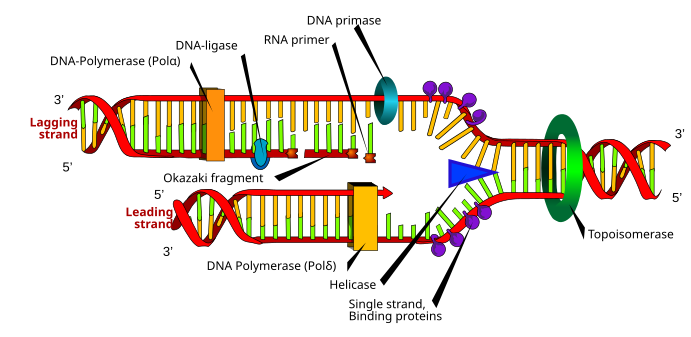
DNA replicates in a semi-conservative manner. What does that mean? Well, it means that the new daughter DNA molecule conserves one strand from the parent DNA molecule. Watson & Crick were the first to suggest this model. Although many other models have also been suggested, the semi-conservative model is the only one that scientists have been able to prove.
There are many enzymes that take part in Replication:
- Helicase
- Gyrase
- SSB or Single Stranded Binding Protein
- Primase
- Polymerase I
- Polymerase III
- Ligase (like a glue that attaches fragments)
Act 1: Initiation
Helicase breaks the hydrogen bonds between the complimentary base pairs and untwists the DNA helix, opening a bubble.
Since DNA is unstable when not in a twisted form, SSB protein is released so it does not twist back together.
When a section of the molecule is unwound, it causes tension in the structure. Gyrase is present to cut the ends of the molecule to release the added tension.
Primase produces Primer (RNA) which signals Polymerase III to add the complimentary base.
Act 2: Elongation
A new strand grows in a 5' to 3' direction, which is the case for the new daughter strand.
Since DNA is antiparallel, the new strands will grow in the opposite direction of each other. There are two types of growing strands: Leading and Lagging.
Leading (Continuous strand):
The leading strand has Polymerase III continuously adding nucleotides to the Primer.
Lagging (Fragmented strand):
This strand grows in sections away from the tip of the fork. These discontinuous sections are called Okazaki fragments.
Act 3: Termination
Upon meeting a Primer of a second Okazaki fragment before it, Polymerase I is released to replace the RNA with DNA. Polymerase I is like a corrector.
Ligase is released to attach these fragments together.




Very detailed explanation to DNA replication. The understanding of this conception will be very helpful in many other aspects like drug discovery and development.
ReplyDeleteThanks for sharing the detailed info about DNA replication. What can you help with cDNA library screening?
ReplyDelete